Magnet Wire
Since the 1800’s, electric vehicles have been second-class citizens to gas-powered vehicles. That changed in 2017 when the Tesla Model S P100DL stole the spotlight and crown from every type of high-performance car currently in production. It thundered its way into the history books with the fastest 0 to 60 mph acceleration time ever recorded (2.275 seconds).
Without the crucial role that magnet wire plays in Tesla’s electric engines, however, this revolutionary feat would merely be a dream. MWS produces and maintains the world’s largest inventory of magnet wire, enabling inventive revelations to become historic realities.
The application of magnet wire-based electric motors in vehicles is the future of automotive transportation. Higher performance coupled with a lighter carbon footprint creates an undeniable allure to consumers, manufacturers, and society in general.
Essential to powering the modern world
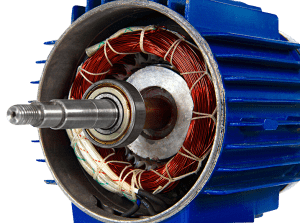
Wire used for winding in electrical equipment is referred to as magnet wire (also sometimes as motor wire or winding wire). In simplest terms, magnet wire is used for interchanging electrical energy with magnetic energy. The most common magnet wire is copper insulated wire used in electric motors – one of the greatest inventions of all time, right up there with the wheel and light bulb. Magnet wires can be divided into broad categories that include enameled wire, covered (or served) wire, or combinations of the two.
Magnet wire types can be quite varied but will include the following features: (a) uniformity of insulation, (b) good electrical properties like dielectric strength and insulation resistance, (c) resistance to mechanical stress, (d) resistance to chemicals, solvents, and encapsulating varnishes, (e) thermal resistance, and (f) long thermal life. Any magnet wire should exhibit strong properties in one or more of these features. Each type has its own advantages and disadvantages, the main idea being that an electric current makes a magnetic field. Therefore, operating conditions are critical in selection of wire type for any specific application.
The main idea is that an electric current makes a magnetic field. You can increase the strength of this magnetic field by increasing the current or by making multiple loops.
Electric vehicles – no longer questioned about performance
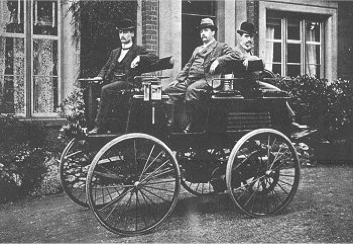
Electric vehicles have been viable since the mid-1800s. Robert Anderson received the first electric car patent in England in 1840.
Pictured here is an English electric vehicle in 1887. While over-shadowed by internal-combustion motor vehicles, during the twenty-first century, electric vehicles have seen a strong resurgence in the twentieth century due to concerns over global warming, financial incentives, special access to HOV lanes and higher performance.
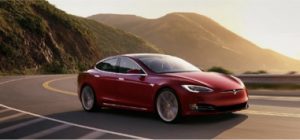
The 4,891-pound Tesla Model S P100D set a record noted around the world when it reached 60 mph from a standstill more quickly than any other production vehicle ever tested by Motor Trend. No production car had ever cracked 2.3 seconds from 0 to 60 mph. But the Tesla did it in 2.275507139 seconds.
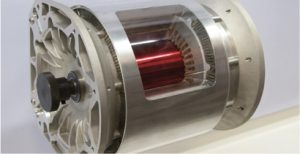
Over half a mile of magnet wire is used in both the front and high-performance rear engines of each Model S. Although high-speed is not necessary to navigate a vehicle in today’s crowded cities and congested highways, the Tesla achievement removes any doubt about the performance potential for an electric powered vehicle.
What’s next for electric vehicles? NextEV!

The Chinese startup electric car company NextEV unveiled its new brand NIO in London at the Saatchi Gallery in November 2016 and launched what it said was the fastest electric car in the world. The NIO EP9 has 1,360 hp which propels the car from rest to 160 mph in 7.1 seconds. This new supercar will match or exceed the performance of top hybrid supercars, such as the Porsche 918 Spyder, LaFerrari and McLaren P1. The car will go on sale in China next year, and then around the world. No word yet on price. The company said it will eventually produce a range of electric cars for the mass market.
Magnet Wire Insulations
Modern magnet wire typically uses one to four build thicknesses (in the case of quad-film type wire) or polymer film insulation, often of two different compositions, to provide a tough, continuous insulating layer. Magnet wire insulating films use (in order of increasing temperature range) polyvinyl formal (Formvar), polyurethane, polyamide, polyester, polyester-polyimide, polyamide-polyimide (or amide-imide), and polyimide. Polyimide insulated magnet wire is capable of continuous operation at up to 240 °C . The insulation of thicker square or rectangular magnet wire is often augmented by wrapping it with a high-temperature polyimide or fiberglass tape, and completed windings are often vacuum impregnated with an insulating varnish to improve insulation strength and long-term reliability of the winding.
Self-supporting coils are wound with wire coated with at least two layers, the outermost being a thermoplastic that bonds the turns together when heated.
Other types of insulation such as fiberglass yarn with varnish, aramid paper, craft paper, mica, and polyester film are also widely used across the world for various applications like transformers and reactors. In the audio sector, a wire of silver construction, and various other insulators, such as cotton (sometimes permeated with some kind of coagulating agent/thickener, such as beeswax) and polytetrafluoroethylene (Teflon) can be found. Older insulation materials included cotton, paper, or silk, but these are only useful for low-temperature applications (up to 105°C).
For ease of manufacturing, some low-temperature-grade magnet wire has insulation that can be removed by the heat of soldering. This means that electrical connections at the ends can be made without stripping off the insulation first.
History of the Electric Motor
In the early 1800s, electricity was in the air. Inventors in Europe and America were coming up with new theories and inventions all the time. They typically knew nothing about each other and developed similar solutions independently.
Timetable 1800 – 1834: First experiments with electromagnetic devices
1800 For the first time Allessandro Volta (Italian) produces a continuous electrical power (as opposed to a spark or static electricity) from a stack of silver and zinc plates.
1820 Hans Christian Oersted (Danish) finds the generation of a magnetic field by electric currents by observation of the deflection of a compass needle. This was the first time a mechanical movement was caused by an electric current
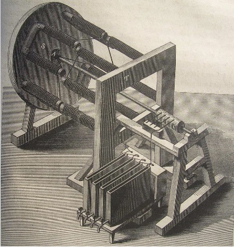
1820 André-Marie Ampère (French) invents the cylindrical coil (solenoid).
1821 Michael Faraday (British) creates two experiments for the demonstration of electromagnetic rotation. A vertically suspended wire moves in a circular orbit around a magnet.
1822 The first rotating device driven by electromagnetism was built by the Englishman Peter Barlow (Barlow’s Wheel).
1825 William Sturgeon (British) invents the electromagnet, a coil of wires with an iron core to enhance the magnetic field.
1827 Jedlik (Hungarian) invents the first rotary machine with electromagnets and a commutator. However, Jedlik publicly reported his invention only decades later and the actual invention date is uncertain.
1830 Johann Michael Ekling, mechanic in Vienna, builds a motor according to the plans and ideas of Prof. Andreas von Baumgartner (Austrian physicist) this apparatus was acquired in 1830 by the University of Innsbruck for the price of 50 Austrian florins. The year of construction is unknown, but must have been before 1830 as the date of purchase is proven.
1831 Michael Faraday (British) discovers and investigates electromagnetic induction, i.e. the generation of an electric current due to a varying magnetic field (the reversal of Oersted’s discovery). Faraday lays the foundation for the development of the electric generator.
1834 After many other attempts with relatively weak rotating and reciprocating apparatus the German-speaking Prussian Moritz Jacobi created the first real rotating electric motor that actually developed a remarkable mechanical output power.
1838 Jacobi sets a world record only four years after creating the rotating electric motor in 1834. His second motor was powerful enough to drive a boat with 14 people across a wide river.
Early motors typically wrapped copper wire with cotton insulation.
1837 Thomas Davenport patents the electric motor. There are several texts of dripping pathos in US-American literature that celebrate Thomas Davenport as inventor of the electric motor. This assertion is based on the undisputed fact that Davenport was the first American who created a usable electric motor and also the first to receive a patent for such a device. From 1837 to 1866 about 100 patents on electric motors were granted to other inventors in England alone. Since Davenport redesigned his motor in 1837, his patent became practically worthless.
The Beginning of Magnet Wire
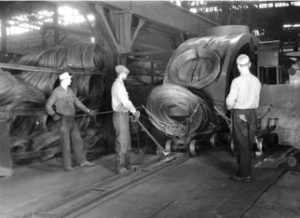
1907 George A. Jacobs, an American inventor, created an insulating process that allowed copper wire to be made in extremely precise gauges. This enamel insulation was long-lasting, less bulky, and more economical. At this time, Jacob formed the Dudlo Company which soon became the largest producer of insulated copper magnet wire.
1911 George Jacobs and his associate, Victor Rea further developed wire of any thickness to be coated evenly with a chemical insulation that could be baked on in special ovens and yet remain flexible enough to be wound into coils.
1927 Dudlo Company merged with two other companies to form General Cable Corporation.
1929 General Cable produced the first 75,000-volt submarine cable in the United States for the Delaware River Crossing. It was manufactured in 4,050-foot lengths — the longest ever without joints.
1933 Victor Rea forms Rea Magnet Wire, and receives its first order form Jefferson Electric Company for 10,000 pounds of 38-gauge enameled wire on three-inch spools.
1936 Essex entered the magnet wire manufacturing business by acquiring a vacant industrial complex that had formerly been the Dudlo Manufacturing Company in Fort Wayne, Indiana. Dudlo was the originator of the modern magnet wire enameling process (see 1906).
Fast-forward to the 1940’s, where we see magnet wire manufacturers working tirelessly to provide support WWII efforts. Essex was producing enough magnet wire to build the millions of transformers used by America and its allies during World War II, produced thousands of miles of field telephone wire for the Army Signal Corps, and wiring harnesses for B-24 bombers.
1954 Essex moves its headquarters to Fort Wayne, Indiana. Five years later, Rea would move its headquarters to Fort Wayne as well.
1963 Ultra-fine wire developed by Sumitomo Electric.
1966 Elektrisola arrives in the market with the first 10-kg-spool for 0.05 mm wire.
1970 Thermal resistance ATZ-300 developed.
1977 Super-fine rectangular wire developed by Sumitomo Electric.
1994 Magneflex is introduced, which features aluminum conductors insulated with a high temperature resin. The advanced polymer coatings have been very successful in transformer applications.
1997 REA introduces Pulse Shield, which is resistant to voltage stresses generated by high frequency, rapid rise time and voltage spikes typically introduced by IGBT-type inverters.
1998 Essex acquired Active Industries, a converter/fabricator of electrical insulation products used mainly by OEMs and motor repair shops.
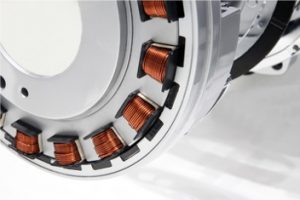
2014Nano Shield introduced by Rea, which shows exceptional resistance to voltage stresses generated by high frequency, rapid rise time, and voltage spikes typically introduced by IGBT-type inverters, increased motor life significantly over standard MW-35C magnet wire under these voltage stresses and across a wide temperature.
Magnet wire can be found in electric motors, which translate electrical energy into mechanical motion through the interaction of magnetic fields and current-carrying conductors. These electric motors contain copper coils, which produce the magnetic fields.
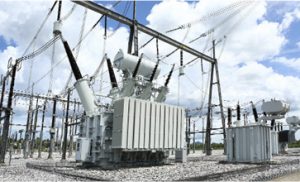
Electric motors are featured in a variety of products, including fans, household appliances, heavy machinery, and automobiles. They come in a range of shapes and sizes, with the smallest being found in electric wrist watches, and the largest in large ships. Some benefits of the electric motor include low cost, low maintenance requirements, no fossil fuels, and many more.
Magnet wire can also be found in transformers, which are essentially devices that transfer electrical energy from one circuit to another through copper coils. Power can be transferred through a magnetic field, rather than a metallic connection between the two circuits. Aluminum wire can be used, however, copper magnet wire is preferred because it is more space efficient and can be wound tighter. Transformers are more influential than one expects- all but a tiny fraction of the world’s electrical power passes through a series of transformers by the time it reaches the consumer.
Conductivity and Connections
The copper vs. aluminum windings in motors debate is still a hot topic. Today, engineers in all sorts of industries question whether the quality and performance of aluminum windings can compare to copper.
In the 1960s, aluminum house wiring faced some controversy due to the fire hazards it created. Connection problems turned out to be cause of these house fires, not the wire itself. When in action, the junctions would overheat, causing the heat to transfer to the wire itself, eventually weakening the wire insulation.
Consequently, aluminum wire tends to receive a negative standing, despite it being reasonable material for motor windings in many applications.
What Else Can Magnet Wire Do?

Magnet wire can be found in a plethora of everyday items, even in planes. Electrically powered model aircraft have been flown since the 1970s, with one unconfirmed report as early as 1957. They have since developed into small battery-powered unmanned aerial vehicles or drones, which in the twenty-first century have become widely used for many purposes.
However, while we may see incredibly fast electric sports cars like Tesla’s on earth, speed in the sky is a different story. Using electrical power to actually propel planes, specifically large, heavy commercial planes, is a more complicated challenge. In a conventional jet airplane, the engine sucks air in through its front, a compressor squeezes it and fuel is sprayed in and lit, creating burning gases and forward thrust. Electric plane power is much simpler. Batteries power an electric motor that spins a propeller. It’s more efficient, but involves far less thrust, which is why electric planes tend to be slow. It may be a lot more eco-friendly, but for now, commercial electric planes aren’t as efficient with our busy travel schedules.
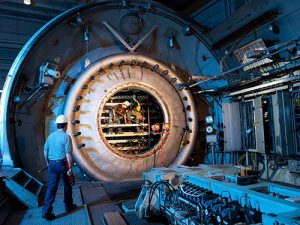
Magnet wire can also be used to power wind tunnels. Wind tunnels are used to test automobiles and aircrafts. Specifically, they help engineers determine the performance of, and eliminate “bugs” in, new designs of civil and military aircrafts and vehicles without risking the safety of a test driver/pilot or costly aircraft. The biggest wind tunnel on the planet is at NASA’s Ames Research Center. This subsonic tunnel, which can test planes with wing spans of up to 100 feet, is more than 1,400 feet long and 180 feet high. It has two test areas: one 80 feet high and 120 feet wide, the other 40 feet high and 80 feet wide. Air is driven through these test segments by six 15-bladed fans. Each fan has a diameter equivalent to the stature of a four-story building. The fans are fueled by six 22,500-horsepower electric motors that use magnet wire to help power them.
Most Powerful Electric Motor
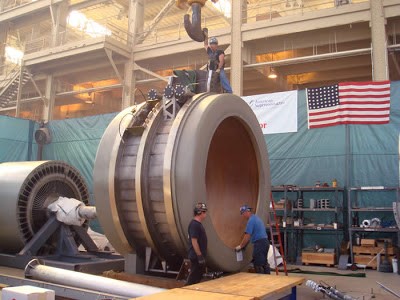
Northrop Grumman Corporation has developed for the U.S. Navy the world’s first 36.5 megawatt (49,000 horsepower) high temperature superconductor (HTS) ship propulsion motor, double the Navy’s power rating test record.
Incorporating coils of HTS wire that are able to carry 150 times the power of similar-sized copper wire, the motor is less than half the size of conventional motors. It will help make new ships more fuel-efficient and free up space for additional war fighting capability.
This system was designed and built under a contract from the Office of Naval Research to demonstrate the efficacy of HTS motors as the primary propulsion technology for future Navy all-electric ships and submarines. Naval Sea Systems Command (NAVSEA) funded and led the successful testing of the motor.
Drive System for the World’s Largest Dump Truck
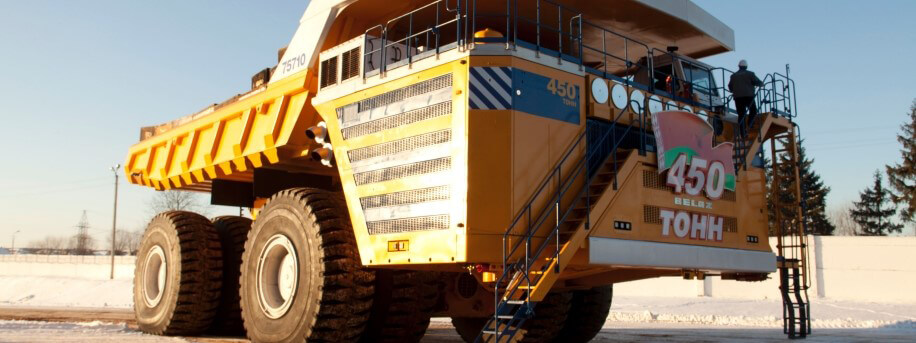
This truck can transport loads weighing over 500 metric tons — equivalent to more than 350 VW Golf cars or seven fully loaded Airbus A320-200 planes. The truck is driven by four 1,200 kW electric motors. It can carry its load at a lower cost per ton of transported material than ever before and has a top speed of 64 km/h when it’s empty.
The engineers at Siemens Drive Technologies were asked to develop an electric drive that would move a truck with a gross vehicle weight of up to 810 tons and would ensure that this truck was able to transport mined material quickly and reliably. In contrast to the previous model, this new truck is outfitted with eight tires, because each tire is designed to carry a load of about 100 metric tons.
The all-wheel-drive allows for a dynamic power distribution between the truck’s two axles. If one of the electric motors were to fail, the truck would still have emergency drive capability, meaning that it could be driven to a workshop under its own power — in other words, it doesn’t have to be towed. The truck was first unveiled to the public in October 2013. It is over 20 meters long, almost ten meters wide, and around eight meters tall. Its all-wheel drive and four-wheel hydraulic steering ensure that the tires, which are around four meters tall, don’t get stuck in rough terrain.
